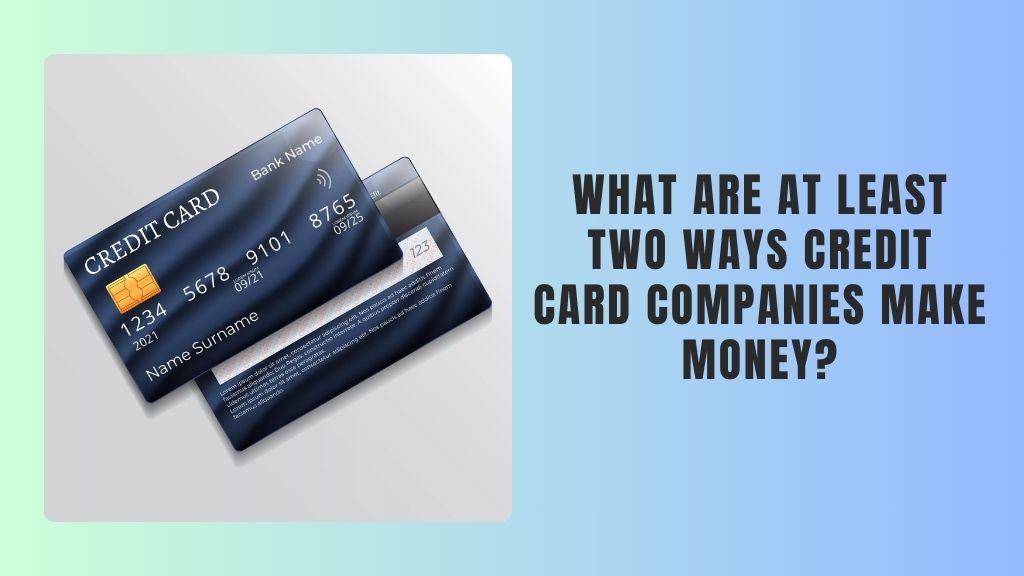Credit cards are widely used for shopping, paying bills, and even booking travel. While they offer great convenience, many people often wonder how credit card companies earn money by giving people the ability to spend now and pay later. In this blog, we will clearly explain the topic, “What Are at Least Two Ways Credit Card Companies Make Money.” Understanding this can help you become a more informed user of credit cards. Credit card companies are not just offering a free service—they are in the business to earn profits. They make money in multiple ways, and knowing these methods can help you avoid unnecessary charges.
Let’s explore in simple terms how these companies earn, and what you can do to protect your hard-earned money.
What Are at Least Two Ways Credit Card Companies Make Money?
1. Interest Charges on Outstanding Balances
One of the main ways credit card companies make money is through interest charges. This is also known as finance charges. When you use your credit card and do not pay the full bill amount by the due date, the company charges you interest on the remaining balance.
How Does This Work?
Each credit card has something called an Annual Percentage Rate (APR). If you do not pay your full bill on time, the remaining amount will start collecting interest based on that APR. Some credit cards have high-interest rates—sometimes as high as 25% or more.
Example:
Imagine you spent $1,000 using your credit card. If you only pay $300 and leave the remaining $700 unpaid, interest will be charged on the $700. Over time, if you continue to pay only the minimum amount, the interest will keep adding up. This helps the credit card company earn a lot of money.
Also read: Who Do You Contact if You Have Questions About Repayment Plans?
Why Do People End Up Paying Interest?
- They forget the due date.
- They do not have enough money to pay the full amount.
- They think paying the minimum due is enough.
Tip:
To avoid interest, always pay your credit card bill in full and on time.
2. Fees and Charges
Credit card companies also make a good amount of money through different types of fees. These charges are applied in certain situations and can often be avoided if you are careful.
Types of Common Fees:
a. Late Payment Fees
If you miss your payment due date, you will be charged a late fee. These fees can be between $25 to $40 or even more depending on the bank and how late the payment is.
b. Annual Fees
Some credit cards charge an annual fee just to keep the card active. These fees are usually found on premium cards that offer travel benefits or cashback rewards. It can range from $25 to $500 or more.
c. Over-the-Limit Fees
If you spend more than your credit limit, you may be charged an over-the-limit fee. For example, if your card has a $2,000 limit and you spend $2,100, the company may charge a penalty for going over.
d. Foreign Transaction Fees
When you use your credit card outside your home country or shop on an international website, you may have to pay a fee for currency conversion. This is usually around 1% to 3% of the transaction.
Why Do These Fees Exist?
These fees are set to encourage responsible use and to compensate the company for the risks they take in lending money.
3. Merchant Fees (Transaction Fees from Stores)
Another major way credit card companies earn money is by charging merchants a small fee every time someone uses a credit card for payment.
What Are Merchant Fees?
Every time you swipe your card at a store or pay online, the business (store or website) pays a small percentage of the transaction to the credit card company. This is usually between 1% to 3% of the sale amount.
Example:
If you buy groceries worth $100 using your credit card, the store might pay around $2 to $3 to the credit card company.
Why Do Stores Accept This?
Even though they have to pay fees, stores still accept cards because:
- It brings more customers.
- People tend to spend more using credit cards.
- It is safer than handling cash.
4. Cash Advance Fees
Many credit card companies allow you to withdraw cash using your credit card, but this comes at a high cost. This service is known as a cash advance.
What Happens in a Cash Advance?
You can go to an ATM and withdraw money using your credit card. However, from that moment, interest starts building up—there is no grace period like regular purchases. Also, you may be charged a flat fee (like $10) or a percentage (like 5%) of the cash amount.
Example:
If you withdraw $200 using your credit card and the cash advance fee is 5%, you will be charged $10 right away. Plus, you will also have to pay interest daily until you pay the amount back.
Why Is This Expensive?
- No grace period for interest.
- High interest rates.
- Extra processing fees.
Cash advances are a big source of income for credit card companies but can be very expensive for customers.
5. Balance Transfer Fees
Some credit card companies allow you to move debt from one credit card to another. This is called a balance transfer. While some companies offer low or zero interest for a few months, they usually charge a balance transfer fee.
How Does This Work?
If you have a large balance on one credit card, you can shift it to another card that has a lower interest rate. But this transfer often comes with a fee—usually 3% to 5% of the transferred amount.
Example:
If you transfer $1,000 and the balance transfer fee is 3%, you will pay $30 as a fee. The company earns money from this transfer.
6. Selling Cardholder Data (Legally)
Credit card companies may also earn money by analyzing customer behavior and selling the data (in a legal and anonymous form) to advertisers and research firms.
What Type of Data?
- Spending habits
- Frequently visited stores
- Types of purchases
The data is usually shared without personal identification. For example, it might show that “people aged 25–35 spend $300 a month on groceries.”
Why Is This Valuable?
This data helps companies target their ads better. For example, a brand selling energy drinks can advertise more to people who buy them regularly.
7. Co-Branded Partnerships
Credit card companies often partner with airlines, hotels, or retail brands to offer co-branded cards. These partnerships are profitable for both the credit card company and the partner.
How Does This Work?
A card may offer airline miles or hotel points. The credit card company pays the airline or hotel for these rewards. In return, they get new customers who are fans of those brands.
Example:
If you have a card from a famous airline, you may get free miles every time you spend. You are encouraged to use the card more, and both the airline and the card company benefit.
8. Interchange Fees
Interchange fees are a portion of the merchant fee that goes to the bank that issued the credit card. This is another way banks and credit card companies make money every time you use your card.
Why Are These Fees Charged?
They help cover the cost of fraud protection, customer service, and credit risk. They are usually hidden from the customer but help the card-issuing company earn money.
9. Reward Program Breakage
Many credit card companies offer reward points, cashback, or miles. While this seems like a benefit to the customer, not all rewards get used.
What Is Reward Breakage?
When customers do not redeem their rewards or let them expire, the credit card company saves money. This is called “breakage.”
Why Do People Not Use Rewards?
- They forget to redeem them.
- There are too many restrictions.
- Rewards expire too soon.
This unclaimed reward value adds to the company’s profits.
Also read: What Are Two Reasons Someone Might Purposely Choose a Higher Monthly Payment?
Conclusion
Now you know the answer to the question, “What Are at Least Two Ways Credit Card Companies Make Money.” The two most common ways are interest charges and various fees. However, companies also earn from merchant fees, data analysis, partnerships, and more. Being aware of these methods can help you use your credit card more wisely. You can avoid unnecessary charges by paying bills on time, staying within your credit limit, and reading the fine print. Credit cards can be useful tools when used responsibly. Remember, credit card companies are not offering free money—they are businesses that earn profit from every swipe you make.

